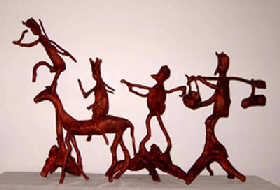Process

Pilgrimage to the West
The process of creating root art includes four steps:
1. Root selection. This has to be done with respect to both quality and shape of the natural root. Quality refers to the breed and the firmness of the crude root. Generally speaking, hard roots are preferable since soft or rotten ones are of little value for root-art creation. The shape of the root must possess its own characteristics, such as a kraurotic buttress root. To select roots with a complex shape is of equal importance. In this way, the carving can be done using different concepts.
2. Conception. A necessary feature of root-art creation is originality. While root carving, the creator must make the best use of the original shape of the root and not alter its original shape so he or she can explore its natural beauty. With this in mind, the creator can then use his or her imagination and find the best concept.
3. Processing. When the concept is clarified, the superfluous roots can be sewn or clipped, and the bark removed. Then, it is necessary to polish the bald root with abrasive paper.
4. Coloring and lacquering. This is done for the benefit of antisepsis and collecting purposes. Two methods are commonly employed for coloring: one is to wax it so the artwork takes on its original color, which is simple and elegant; the other is to stain it with bronze lacquer, which can add a touch of antiquity to the root.
The most important principle to follow in root carving is to make use of the natural root. This principle usually goes like this: "three-tenths (of the work) is done by man, seven-tenths is determined by nature," attaching great importance to making use of the traits of the natural root, such as the fibers, holes, knurs, veins, color and luster. With a motif in mind, the creator should employ different carving techniques on roots of different shapes; the ultimate purpose is to integrate the unique beauty of the natural root with the cunning beauty attained by carving. Since root carving is largely done by making use of the natural beauty, the opus is of an integrated style.
The second principle is highlighting the composition. There are quite many modes of composition in root carving, and the one most common is the "triangle setup", which is usually employed in sculpture. Other geometrical shapes, such as circles, ellipses and lozenges, are also used to further composition.










